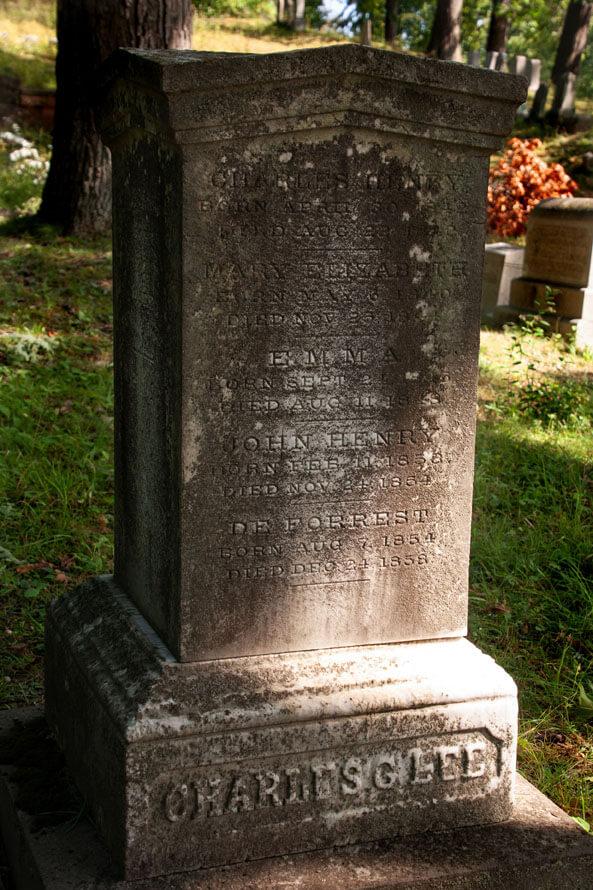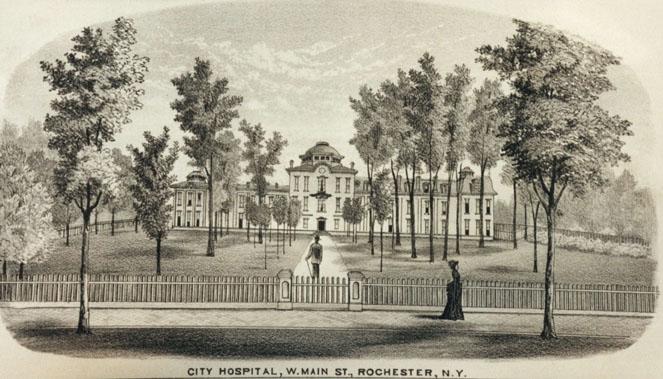Part 1
I’m going to whine about the difficulties of historical research. The original owner of my house at 80 Glasgow Street was a widow named Elizabeth Lee. She is a perfect example of how historical records are often obscure or contradictory. According to her obituary, the former Elizabeth Case of Philadelphia was 89 years old when she died in February of 1893. That could mean she was born in 1804. If her birthday occurred later than February, she could have been born in 1803. Her burial record at Mount Hope Cemetery says she was 88 years old (possibly born in 1805?). The obituary goes on to say that she came to Rochester in 1821 at the age of 16. The cemetery record seems more promising.
Elizabeth moved to western New York to live with an uncle, Dr. John D. Henry, reportedly the first physician to come to the village of Rochester. Citing the obituary, she assisted him in his practice by “nursing the sick and…performing the duties of an undertaker.” The doctor’s wife Hannah had recently died, leaving him with 5 small children. But Hannah died December 26, 1821 in Greene, New York, so the doctor probably didn’t come to Rochester until 1822. This also offers a more likely reason Elizabeth Case came to live with her uncle—to help him with those five children. She may have assisted in medical duties as well, but the children would seem to be a more pressing problem.
When Elizabeth married Charles M. Lee on February 10, 1825, a newspaper account said she was the daughter of H. Case, Esq. of Indiana. It’s entirely possible that Mr. Case had moved from Philadelphia to Indiana after Elizabeth arrived in Rochester, but the inconsistency must be noted. A subsequent census record confirms that Elizabeth was born in Pennsylvania.
Charles M. Lee, an attorney from Lyme, Connecticut, arrived in 1821. I can confirm this information. In the Rochester Telegraph of August 14, 1821, an advertisement appeared announcing that Charles M. Lee just “opened an Office in the village of Rochester.” An article appeared in the Democrat and Chronicle on February 16, 1874 entitled “Lyme, The Connecticut Town Where the Lawyers all Came From.” Charles and his brother E. Smith Lee were both listed.

Less than a year after Charles married Elizabeth Case, Dr. Henry remarried. His bride’s name was Elizabeth Case! As though my head were not spinning enough already, another family twist took place.
Charles Lee had been previously married although I don’t his wife’s name. Did she die in Connecticut or Rochester? They had a son Charles G. Lee who was born on May 5, 1814. Mount Hope Cemetery records say he was born in Rochester but that can’t be right because his birth would predate his father’s arrival in the village. Years later, he married Dr. Henry’s daughter Caroline—one of those children that his stepmother may have come to the village to care for back in 1822!
Other complications also make people difficult to track. Prior to 1850, census records only list the head of the household. Other family members are grouped by gender and age. For example, in 1830 there are 7 people living in the Charles M. Lee household: a male between the ages of 40 through 49 (presumably Charles M.); another male, 15 through 19 (Charles G.); there are three females between 20 and 29—Elizabeth would have been one, the others may have been servants; a male between ages 20 through 29 and a female between 10 and 14. I have no idea who they were.
Mount Hope Cemetery opened in October of 1838. People who died prior to that date, buried in other cemeteries, were sometimes moved to this new location years after their deaths. Both of Dr. Henry’s wives are with him even though Hannah died in 1821.
Monuments and grave markers can provide useful facts. The monument in Charles G. Lee’s plot lists his children including dates of their births and deaths. But weather conditions such as acid rain and botanical growth have rendered the information difficult, if not impossible, to read.
Everything I’ve described so far, took place in the Fifth Ward on St. Paul Street. Next month, I will tell you how Elizabeth (Case) Lee ended up in the Third Ward to build my house.
Part 2
The 1850 Federal Census reveals that Charles M. Lee owned real estate valued at $130,000. Some of it was for speculation in property, common at the time though not without risk. In 1842, an uninsured rental property of his burned down, a curious oversight by the attorney.
Nonetheless, Lee and his wife, the former Elizabeth Case were living very comfortably. They were pioneers in a rapidly growing village, having arrived in Rochesterville shortly before the Erie Canal was completed from Albany to the Genesee River (1823) and, by mid-century, they were raising two sons, William S. (age 6) and James Case Lee (2) in a stone house they’d built on the west side of St. Paul Street just south of Andrews.
Charles G. Lee and his wife lived across the street in a home near where World Wide News stands today. The younger Charles attended Yale University but his post-college life was a strange mixture of professions: grocer, a hardware merchant, a Major and Brigade Inspector for Rochester’s militia. Once he even appears as Reverend Lee. His wife gave birth to five or six children but several of them died in the first years of life—those names and dates I couldn’t make out on the grave marker pictured in last month’s Gazette.
Suddenly, over a seven-week period during the fall of 1856, Elizabeth’s life turned upside down. On October 9, forty-two year old Charles G. died of consumption, leaving “a widow and three children of tender years to mourn his early death.” In late November, Charles M. Lee, Elizabeth’s 68-year-old husband, was diagnosed with erysipelas, an inflammation of the skin that would be treated today with antibiotics. In the mid-1800s, it was fatal.

On March 24, 1857, the Rochester Daily Union (forerunner to the now defunct Times Union) announced that the “elegant homestead of the late Charles M. Lee, on St. Paul [street, sold for] $11,500, a low price if the cost of the house and improvements is taken into consideration.” It appears that there were many claims to Attorney Lee’s estate, perhaps because those real estate investments left him land rich but cash poor. Elizabeth may have had to settle for what she got.
By 1859, the widow was living in a Third Ward home—today’s 67 Atkinson Street. The 1861 city directory shows her living at 41 Glasgow (#80 today). On the outside, the house is the mirror image of the Atkinson Street home. City records say #80 was built in 1864 but this record suggests it may have been built as early as 1860. Located several blocks south of the expensive homes in the “Ruffled Shirt District,” this must have been a comedown for the Lee family who, a few years earlier, had been living with servants in the “elegant” St. Paul Street home.
Elizabeth was very active in the Female Charitable Society, an organization founded in 1822 by Everard Peck and his first wife Chloe in their South Fitzhugh Street home. In 1834, following Chloe’s death, Peck boarded briefly in the home of Dr. John D. Henry, Elizabeth’s uncle. This may be how Elizabeth became active in the Society and she pursued it with passion.
She became a founding member of the Rochester Orphan Asylum that opened on Hubbell Street in April of 1844. Elizabeth’s house on Glasgow was just two blocks away and, during the final years of her life, she served as its honorary director. The following year, she and the Society began a campaign to build a much-needed hospital. Mount Hope Cemetery had opened in October of 1838 so Rochester’s Common Council gave the Society the grounds of an older cemetery on Buffalo Street (West Main). First, the bodies had to be exhumed and moved to Mount Hope—a long, slow process. When City Hospital opened in 1864, it was Elizabeth’s homage to Dr. Henry, the uncle who brought her to Rochester more than forty years earlier.
On February 22, 1893 Elizabeth Lee died in her Glasgow home leaving a legacy that has grown in stature. City Hospital expanded its services, changed its name to Rochester General Hospital and eventually relocated to Irondequoit. On January 8, 1901, fire destroyed Elizabeth’s beloved Orphan Asylum killing 28 children and three adults. It was rebuilt in the Cobbs Hill area where it is known today as the Hillside Family of Agencies.
